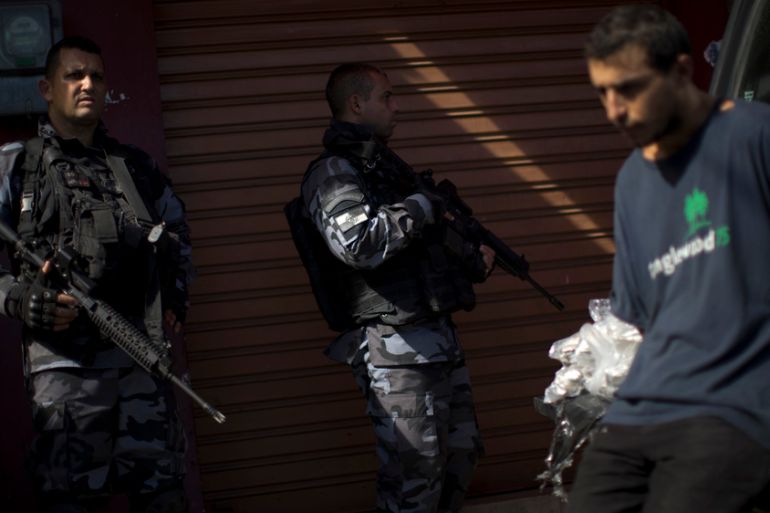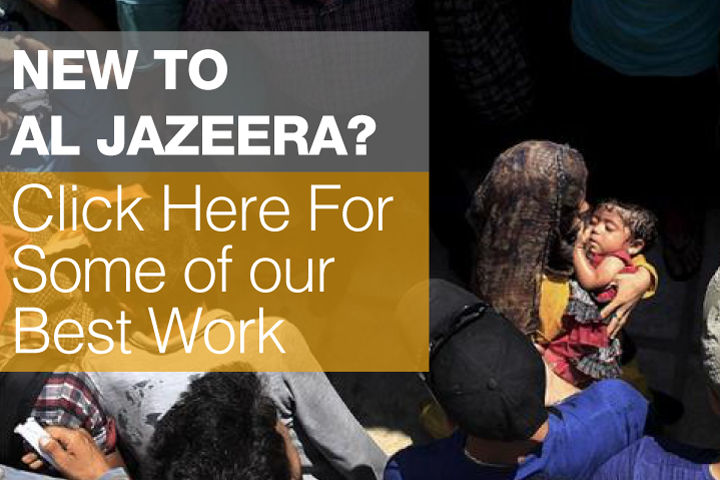Drug war consumes Brazil’s Amazonian capital
Homicide rates skyrocket fuelled by growing local drug market and increasing demand for cocaine in Brazil and Europe.

Manaus, Brazil – “Little Ricardo” tried to find a job but failed because of a criminal record for robbery as a teenager.
Today he sells cocaine, crack, and marijuana at a “boca de fumo” – a drug den – in the dusty streets of Santa Etelvina. It is a neighbourhood renowned for drug trafficking and violence, located an hour’s drive from Manaus’ elegant opera house and World Cup arena.
Keep reading
list of 4 itemsWest Africa’s Sahel becoming a drug trafficking corridor, UN warns
Behind India’s Manipur conflict: A tale of drugs, armed groups and politics
Why are some countries decriminalising drugs?
Showing a stab wound on his left side, he said he keeps a revolver at the drug den, which he runs with four others, to ward off robberies. He claimed his gang had already killed a rival who tried to move in on their business. On a good day, he said they take in up to $250, more than Brazil’s monthly minimum wage.
“Now the objective is to open more bocas and spread further into different districts,” Little Ricardo, 23, said.
Little Ricardo is a small player in Manaus’ violent drug trade, which has flourished in recent years as the Amazonian capital has grown into a major transit point, supplying an increasing domestic and European demand for cocaine.
|
|
| Risking it all: The river traders of Brazil |
Homicides rose by 166 percent between 2002 and 2012 and stood at 37 killings per 100,000 inhabitants in 2014 – nearly four times Sao Paulo’s murder rate – the majority of which local security officials say is connected to the drug trade.
Manaus, with nearly two million inhabitants, is home to a huge free trade zone and one of Brazil’s busiest ports. It is also the country’s biggest and most prosperous city situated close to drug production territory. The state of Amazonas, where it is located, borders both Colombia and Peru.
Drugs reach Manaus via the Solimoes River then are floated along the Amazon River for distribution in Brazil – now the world’s second largest consumer of cocaine – or shipped to Europe.
Gang violence
The dominant drug gang in Manaus calls itself Family of the North, or FDN. It is controlled from inside the city’s prisons and desperately poor favelas and holds large swaths of drug-dealing territory in the northern and western zones of the city.
RELATED: In Pictures: Crackdown in Brazil’s favelas
Since the late 2000s FDN has been at war with the First Capital Command gang from Sao Paulo, which wants to secure control of the city’s trafficking routes and local trade.
Today, however, Manaus security officials say the majority of the city’s murders are committed by unorganised small-time dealers such as “Little Ricardo”, who are supplied by the bigger groups and kill over territorial disputes and unpaid debts.
Al Jazeera on three occasions visited bloody crime scenes: a woman executed in a bar full of patrons, a man shot in broad daylight as he tried to escape, and a naked body with signs of torture found in a river.
“In the past, most murders were because of personal disagreements. Today, it’s mainly drug traffic,” said Joana Queiroz, a Manaus reporter who’s covered the city’s crime beat for 25 years. “The traffickers kill to show their power. If you owe a trafficker you’ll pay with your life.”
|
|
| Brazil’s police crack down on drug gangs |
Strategic location
Analysts say in the last 10 years the cultivation of cocaine has been modified and it is now being grown a short distance over Brazil’s border with Peru. The reduced distances and smuggling costs have led to an influx of availability.
The importance of Manaus as a transit point has grown since the early 2000s when Amazonian criminals were imprisoned alongside leaders of Rio de Janeiro’s oldest and most powerful drug trafficking gang, the Red Command.
The gang subsequently established a base in the region to receive drugs and weapons from Colombia’s rebel group, the Revolutionary Armed Forces of Colombia (FARC).
As is usually the case with major drug transit points, Manaus developed its own lucrative internal market and today bags of cocaine go for as little as $5 and Oxi – a highly addictive crack cocaine derivative made from cocaine paste and kerosene – for just $2 a “rock”.
“It’s a very difficult life. When you get some money, even if you’re hungry, you’ll spend the money on drugs. You forget everything for the drugs,” said Andre, 31, a homeless Oxi addict.
RELATED: Drug wars and police killings in Brazil
To stem the drug trade, security officials say they are concentrating on seizing large quantities of drugs and going after the big dealers, making less but more effective arrests.
“It’s always going to arrive… But we don’t want it to be easy, the less that gets through, the higher the price on the street,” said Sergio Fontes, secretary of public security of the state of Amazonas.
|
|
| Inside Story Americas – Brazil: Protests of discontent |
So far this year, drug apprehensions are more than triple that of 2014.
Al Jazeera was there for the biggest haul of the year, about 800kg of cocaine and marijuana, which according to police intelligence was headed for the northeast and southeast of Brazil.
Security officials admit, however, that increased apprehensions are also accelerating the violence, as the dealers fight over the remaining drugs and commit more robberies to raise lost capital.
“It has a cost. What is the cost? Increasing violence in the spaces left over,” Fontes said.
Statistics given to Al Jazeera show murder rates increased by 24 percent by August, compared with the same period last year. In July, 37 people were killed in a single weekend, allegedly by off-duty police reacting to the murder of a colleague.
RELATED: Sao Paulo massacre highlights disturbing trend in Brazil
Security officials say to combat homicides they are putting more police on the streets and conducting constant operations, but the increased force is unlikely to be an effective deterrent for recruits eager to enter the drug trade.
Manaus is the capital city of the fourth-poorest state of Brazil and according to a recent survey by the Brazilian Institute of Applied Economic Research, it has the worst economic and social indicators out of any big Brazilian city.

“If the current strategies continue, the natural tendency is for homicide rates to continue to increase as smaller groups fight for control of the drug points and the larger groups for strategic areas of the city,” explained Rafael Salies, director of Brazilian operations at Southern Pulse, a risk advisory firm specialising in Latin American public security.
On a Saturday night, police swarmed Manaus’ crime ridden Parque Sao Pedro neighbourhood, performing checks on passing cars and motorbikes, looking for drugs and weapons.
Sergeant Hilmar told Al Jazeera it was highly unlikely they would find anything as word would have already gone out about the checks.
“We will disrupt them for one night. Tomorrow they will be back to normal,” said the sergeant.